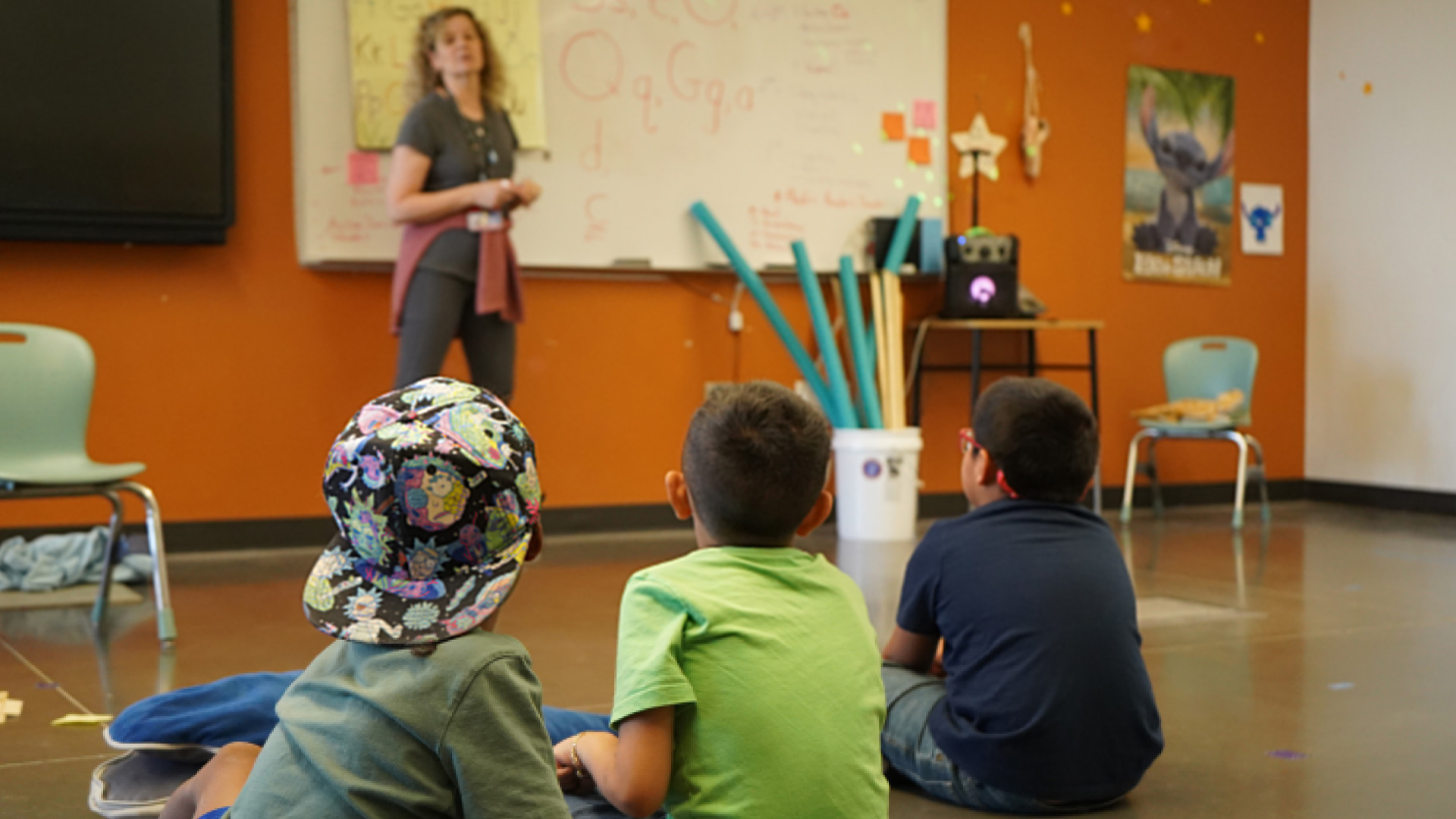 Three kindergarden boys listen to Amy Stallman, the OMA teacher, during TUSD summer school program at the Mary Belle McCorkle Academy of Excellence.
Three kindergarden boys listen to Amy Stallman, the OMA teacher, during TUSD summer school program at the Mary Belle McCorkle Academy of Excellence.
Five years after the COVID-19 pandemic shuttered schools across the country, Arizona educators are still dealing with its lingering impacts, especially among the state’s youngest students.
At McCorkle Academy of Excellence in Tucson, a four-week summer school program is trying to fill the learning gaps. As part of a new “hub school” model, the program invites students from across the district who struggled during the school year, including kindergartners who began school without basic early learning skills or fell behind in their first year.
But participation is optional—even for the students who need it most. On a recent visit during the program’s final week, only one child showed up for the kindergarten class.
“Kids are not coming into kindergarten ready for kindergarten standards,” said Julia Wilson, a kindergarten teacher in the summer program who also teaches at Grijalva Elementary during the normal school year. “They should be able to read basic sentences like ‘I see a cat.’ But to get there, they need to come in knowing how to write their name and count to 10.”
But teachers are saying that many don’t.
New research from Curriculum Associates shows kindergarten readiness is still slipping after the pandemic. From fall 2021 to fall 2022, more kids started school below grade level, and overall performance declined—roughly equal to a noticeable step back in early learning skills, like recognizing letters or counting.
The drop is linked to major disruptions in early education during COVID-19, including a sharp decrease in pre-K participation and the limited effectiveness of virtual learning for young children.
As Arizona students move into higher grades, the academic gaps left by the pandemic become harder to ignore.
Amy Stallman sees it firsthand in her summer school class, where she helps students connect literacy to movement, turning physical motion into muscle memory. But she says the foundational skills many kids are missing, like letter formation and basic phonics, are difficult to recover.
“If they miss first grade or second grade, they missed a lot of the phonics. They missed a lot of the handwriting,” she said.
During a class visit to the summer school program classroom, only one student in the hub-school kindergarten class showed up. It was the last week of class, but numerous teachers said high absentee rates have been the status-quo.
And according to Wilson, the kindergarten teacher, teachers are also seeing alarming trends in behavior and socialization. COVID-19 disrupted early childhood education just as many children were reaching key developmental milestones and for kindergartners, especially those who didn’t attend preschool or daycare, the pandemic meant missing out on crucial opportunities for socialization.
“These kids… a kid takes their toy and they’ll punch them. Or throw chairs across the classroom,” said Wilson. “It’s not just one kid anymore, it’s across the board. Socialization, behavior, academics. I’m fighting fires all day, and teaching is the last thing I get to do.”
Arizona is one of a handful of states that does not require kindergarten, which means some students are entering first grade having never been in a classroom environment before.
At the same time, pandemic-era funding that once helped schools manage these challenges has dried up. Much of the federal COVID relief money went toward hiring additional classroom support staff, such as teacher aides and behavior specialists. Now that the grants have expired, many of those positions have been cut.
“Having a TA is just helpful for extra eyes, extra support, I can't do everything at once,” said Wilson.
Roseanne Lopez, a longtime public-school educator and administrator who now teaches in the College of Education at the University of Arizona, says as schools adjust to the end of pandemic relief funding, many are grappling with what to cut.
“I think in general, districts spent the money as carefully as you could possibly spend it, knowing that the kids are behind and trying to make up some of that difference through direct services for recovery of learning loss,” she said.
Wilson says, for her, the stakes are high because without sustained funding for classroom support like teaching assistants, behavior specialists, and intervention programs, it’s much harder to reach the kids who need the most help. The temporary relief funds allowed schools to begin addressing the damage, she says, but now that those resources are gone, teachers are left trying to fill widening gaps with fewer tools.
“I’m scared for some of these kids’ futures,” said Wilson.
This story is part of The Long Road, AZPM’s limited series examining how COVID-19 reshaped Arizona and the country over the last five years.

By submitting your comments, you hereby give AZPM the right to post your comments and potentially use them in any other form of media operated by this institution.